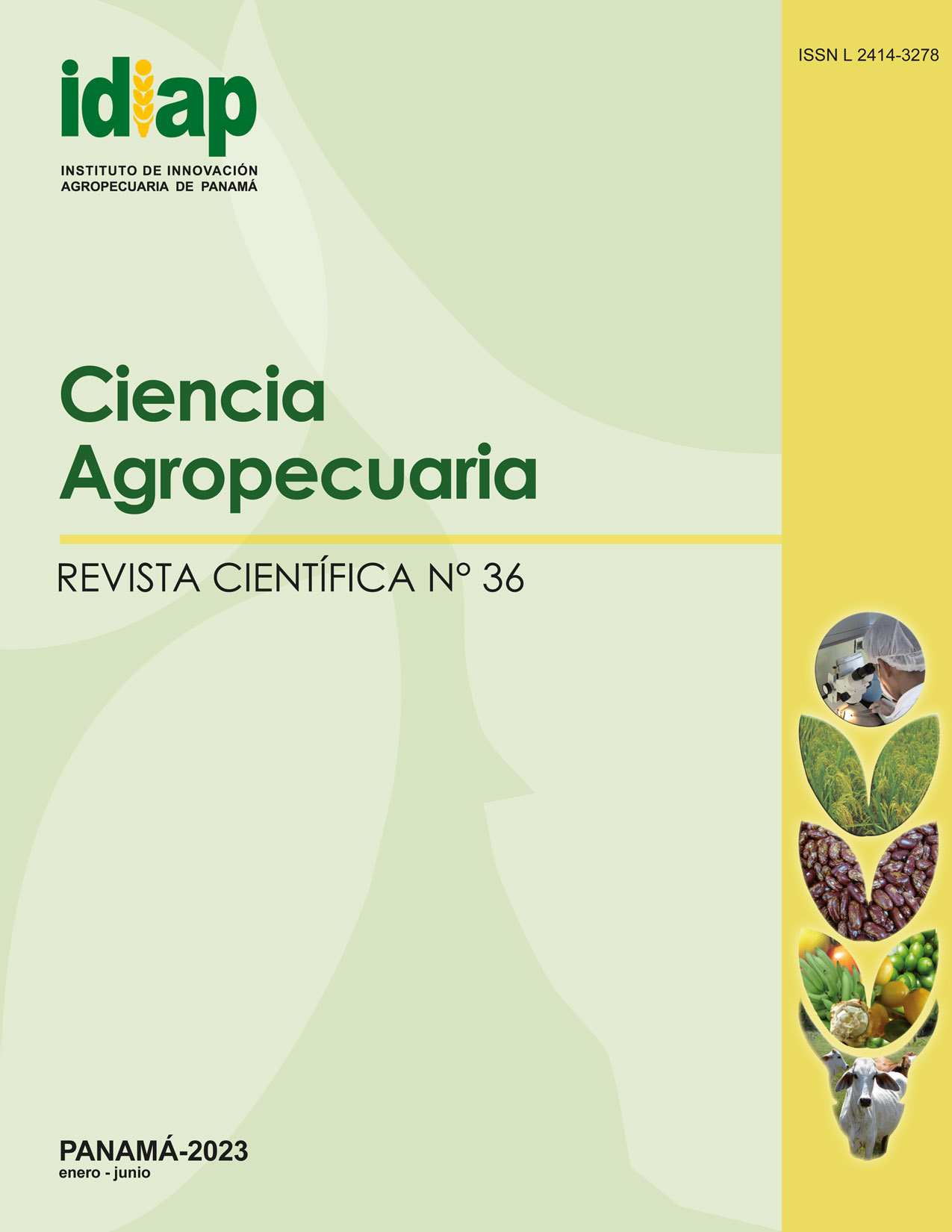VEGETACIÓN ASOCIADA AL GÉNERO Zelus FABRICIUS, 1803 (HEMIPTERA: REDUVIIDAE) EN CERRO PUNTA, CHIRIQUÍ, PANAMÁ
Resumen
El objetivo de este estudio fue identificar las plantas asociadas al género Zelus Fabricius, 1803 (Hemiptera: Reduviidae) en Cerro Punta, Chiriquí, Panamá. Se realizaron 12 recorridos aleatorios en dos localidades, desde octubre de 2019 hasta octubre de 2021; revisando hortalizas y vegetación aledaña. Se registraron las diferentes etapas de desarrollo de Zelus en las plantas observadas, además de colectar especímenes para la identificación en el laboratorio. De acuerdo con los resultados, las dos especies encontradas en Cerro Punta, correspondieron a Zelus longipes L., 1767 y Zelus renardii Kolenati, 1857. Las plantas en las cuales se observó presencia de Z. longipes, correspondieron a naranjo - Citrus sinensis (L.), Osbeck, uchuva - Physalis peruviana L., romero - Salvia rosmarinus (L.) Schleid., 1852, zarzamora - Rubus glaucus Bentham, 1846, maní forrajero - Arachis pintoi Krapov. y W.C.Greg., 1994 y camote - Ipomoea batatas (L.) Lam. Se encontró desde huevo hasta adulto de Z. longipes en naranjo en la primera localidad, siendo las moscas (Diptera) las presas cazadas con frecuencia. La vegetación asociada a Z. renardii, correspondió a naranjo, mastuerzo - Tropaeolum majus L., 1753 y uchuva; encontrando todas sus etapas de desarrollo en la uchuva y se observó depredación de escarabajos de la familia Chrysomelidae. En conclusión, al menos siete especies vegetales en Cerro Punta están asociadas al género Zelus, representado por Z. longipes y Z. renardii. Se observaron todas las etapas de desarrollo de los chinches Zelus en dos especies vegetales, las cuales representan un potencial como plantas refugio.
Descargas
Citas
Albores, C. (2016). Detección del ADN de Diaphorina citri (Hemiptera: Liviidae) en el contenido intestinal de Zelus renardii (Hemiptera: Reduviidae). [Tesis de Maestría], El Colegio de la Frontera Sur, México. https://ecosur.repositorioinstitucional.mx/jspui/bitstream/1017/1893/1/100000057839_documento.pdf
Aguilera, V. (2016). Enfermedades fúngicas de los cítricos en Panamá. Estudio particular de la mancha grasienta causada por Mycosphaerellaceae. [Tesis Doctoral]. Universidad Politécnicade Valencia-ES. 196 pp. https://riunet.upv.es/bitstream/handle/10251/61447/AGUILERA%20-%20ENFERMEDADES%20F%EF%BF%BDNGICAS%20DE%20LOS%20C%EF%BF%BDTRICOS%20EN%20PANAM%EF%BF%BD.%20ESTUDIO%20PARTICULAR%20DE%20LA%20MANCHA%20GRASI....pdf?sequence=1
Atencio, R., Aguilera, V. A., y Arcia, A. A. (2021). Actualidad de la Enfermedad del Huanglongbing (HLB) de los Cítricos en Panamá. Actualidad Agropecuaria. Septiembre, 268, 8-18. https://actualidadagropecuaria.com/revista-digital-actualidad-agropecuaria-septiembre-2021/
Bahena, F., Velázquez, J., y Báez, A. (2012). Manejo Agroecológico de plagas en trigo para una Agricultura de Conservación en el valle Morelia-Queréndaro. Folleto Técnico Núm. 30. Campo Experimental Uruapan. CIRPAC. INIFAP. 74p. https://www.compucampo.com/tecnicos/manejoagroecologicoplagas-trigo-mich.pdf
Barrera, J. F., Gómez-Ruiz, J., y Herrera-Muñoz, J. (2010). Biología y método de cría de Zelus renardii (Hemiptera: Reduviidae), enemigo natural de Diaphorina citri (Hemiptera: Psyllidae). 1er Simposio Nacional sobre investigación para el manejo del Psílido Asiático de los Cítricos y el Huanglongbing en México, 277-291. https://sites.google.com/site/diaphorina/simposiohlb1
Benavides, P., y Góngora, C. E. (Eds.). (2020). El Control Natural de Insectos en el Ecosistema Cafetero Colombiano. Cenicafé. https://doi.org/10.38141/cenbook-0001
Cisneros, F. (2010). El Manejo Integrado de Plagas. Control de Plagas Agrícolas, Fascículo 13. https://hortintl.cals.ncsu.edu/sites/default/files/articles/Control_de_Plagas_Agricolas_MIP_Ene_2010.pdf
Collantes, R., y Pittí, J. (2019). Insectos asociados al aguaymanto en Cerro Punta, Chiriquí-Panamá. Aporte Santiaguino, 12(2), 147-160. http://dx.doi.org/10.32911/as.2019.v12.n2.638
Collantes, R., y Jerkovic, M. (2020). Organismos plaga y benéficos asociados a cítricos de traspatio en Cerro Punta, Chiriquí, Panamá. Aporte Santiaguino, 13(1), 48-58. http://dx.doi.org/10.32911/as.2020.v13.n1.680
Collantes, R., Pittí, J., Jerkovic, M., y Atencio, R. (2021). Frutas con potencial como alimentos funcionales en Cerro Punta, Chiriquí, Panamá. Revista Semilla del Este, 2(1), 1-11. https://revistas.up.ac.pa/index.php/semilla_este/article/view/2460/2246
Collantes, R., Pittí, J., Santos-Murgas, A., Caballero, M., y Jerkovic, M. (2022). Oligonychus ununguis (Acari: Tetranychidae): plaga del ciprés (Cupressus lusitanica Mill.) en Tierras Altas, Chiriquí, Panamá. Revista Investigaciones Agropecuarias, 4(2).
Curkovic, T., Araya, J. E., Baena, M., y Guerrero, M. A. (2004). Presencia de Zelus renardii Kolenati (Heteroptera: Reduviidae) en Chile. Boln. S. E. A. 34, 163-165. http://sea-entomologia.org/PDF/BOLETIN_34/B34-027-163.pdf
Giraldo, M., Galindo, L., Benavides, P., y Forero, D. (2011). Aprenda a conocer las chinches depredadoras de plagas del café. FNC-CENICAFE, CO. 8 p. http://dx.doi.org/10.13140/RG.2.2.33299.07201
González, M. L., Jahnke, M., Morais, R. M., y Da Silva, G. (2014). Diversidad de insectos depredadores en área orizícola orgánica y de conservación, en Viamão, RS, Brasil. 20 Revista Colombiana de Entomología, 40(1), 120-128. http://www.scielo.org.co/scielo.php?script=sci_arttext&pid=S0120-04882014000100020
Google Earth Pro. (2022). Versión 7.3.4.8573 (64-bit). kh.google.com
Kondo, T., González, G., y Guzmán, Y. C. (2017). Enemigos naturales de Diaphorina citri. En: T. Kondo (Ed.). Protocolo de cría y liberación de Tamarixia radiata (Waterston) (Hymenoptera: Eulophidae), (pp. 23-34). Corpoica (Corporación Colombiana de Investigación Agropecuaria) Editorial, Colombia. https://repository.agrosavia.co/bitstream/handle/20.500.12324/1431/110086_67785.pdf?sequence=1&isAllowed=y
Mera, Y., Gallego, M., y Armbrecht, I. (2010). Interacciones entre hormigas e insectos en follaje de cafetales de sol y sombra, Cauca-Colombia. Revista Colombiana de Entomología, 36(1), 116-126. http://www.scielo.org.co/pdf/rcen/v36n1/v36n1a20.pdf
Reyes, A. (2011). Análisis de Hirsutella citriformis Speare (Ascomycota: Hypocreales) y Zelus longipes Linneo. (Het., Reduviidae) como enemigos naturales de Diaphorina citri Kuwayama. [Tesis de Pregrado], Universidad Autónoma Agraria Antonio Narro, México. 63 p. http://repositorio.uaaan.mx:8080/xmlui/bitstream/handle/123456789/4334/T18909%20%20REYES%20MARTINEZ,%20ANA%20YELLY%20%20TESIS.pdf?sequence=1
Sifuentes I., E., Macias C., J., Apodaca S., M. A., y Cortez M., E. (2009). Predicción de la fenología de papa (principios y aplicaciones prácticas). INIFAP-CIRNO. Campo Experimental Valle del Fuerte. Folleto Técnico No. 32. Los Mochis, Sinaloa, México. 54 p. https://www.compucampo.com/tecnicos/prediccionfenologia-papa.pdf
Unigarro P., A. (1958). Biología del Predator Zelus longipes Linneo (Hemiptero: Reduviidae) en el Valle del Cauca. Revista Facultad Nacional de Agronomía Medellín, 18(51), 53-82. https://revistas.unal.edu.co/index.php/refame/article/view/30293
Vergara, E., Echavarría, H., y Serna, F. (2007). Hormigas (Hymenoptera Formicidae) asociadas al arboretum de la Universidad Nacional de Colombia, Sede Medellín. Boletín Sociedad Entomológica Aragonesa, 40, 497-505. http://sea-entomologia.org/Publicaciones/PDF/BOLN40/497_505BSEA40HormigasColombia.pdf
Vila, E., Soler, A., y Parra, A. (2010). El control biológico de plagas con el uso de plantas refugio: Desarrollo de un nuevo sistema para el control de pulgones. Phytohemeroteca. 222. https://www.phytoma.com/la-revista/phytohemeroteca/222-octubre-2010/el-control-biologico-de-plagas-con-el-uso-de-plantas-refugio-desarrollo-de-un-nuevo-sistema-para-el-control-de-pulgones
Wiedenmann, R. (1992). El potencial de los depredadores generalistas para control biológico. Ceiba, 33(1), 27-37. https://bdigital.zamorano.edu/bitstream/11036/3748/1/05.pdf
Esta obra está bajo una licencia de Creative Commons Reconocimiento-NoComercial-CompartirIgual 4.0 Internacional.






